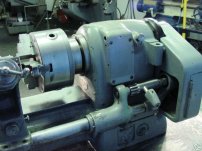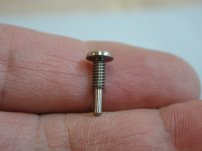mnl
Hot Rolled
- Joined
- Sep 7, 2007
- Location
- Maryland near DC
I could see myself with one of those.
Follow along with the video below to see how to install our site as a web app on your home screen.
Note: This feature may not be available in some browsers.
This particular screw is from the 1950's and although the factory made billions of them, they have not been available new for many years.

Thank you all so far for the advice given. I was not aware of the many choices of small lathes out there that are not Harbor Freight junk. The Chinese lathe with the digital control looks nice and have found posts from people who have one and all reports are good. The basic model costs $5500.
OK, here is an example of what my next project is. I need to copy this screw and make it look exactly like the original one. I probably will make about 20 of them.
The screw is a 4BA size which is .142" diameter and 38.5 TPI with a thread angel of 47.5 degrees. I can't cut 38.5 TPI on any of my lathes so will be cutting the threads with a die.
Although 4BA screws are still common and available new I can't find any that look like this as they are threaded all the way and and are not chrome plated brass. I may use stainless to avoid the plating and have in the past used titanium rivets to make similar screws. I also at times need to make metric, unified, BSW, BSF, BSP and CEI screws and nuts and bolts if I can't find what I need new.
This particular screw is from the 1950's and although the factory made billions of them, they have not been available new for many years. Old ones are always chewed up and not worth fixing. The first two I make are going on a bike like this under restoration. It holds the headlight high/low beam switch to the handlebars. So will be visable and needs to look correct.
That jack shaft speed drive looks like it came from an old sewing machine with a rubber tire to drive the chuck.I wonder if you could find one of the little 4" Myfords ?
One thing for sure, I'd be searching for something with a plain bearing headstock. Those are so much quieter and rounder than anti-friction bearings ... in something little where you're not taking a heavy cut, would be on my priority list.
hang on, hang on ... you want nice ? we got nice

Several interesting-looking little lathes there, besides this one
I made thousands of little parts on my Hardinge 1940's ESM-59 with chase threading, but never used the chase threading feature. All threading was done with taps and a Geometric die head, which was done from the turret. The chase threading attachment would not work while the double tool lever cross slide was mounted, and that cross slide tooling was essential for the parts I made....PS : the later DV's are a little heavier duty and there are some nice things about the dovetail bed. OTOH, AFAIK, you won't find a chase threading rig or geared compound off the headstock on any of them nor provision on the bed for same. For straight turret ops, they are a little nicer. All the accessories tend to be a little more recognized and expensive with DV bases. Same late model tooling can be found on split-bed bases since Hardinge was assiduous in making most tooling from 1900 through the late 1980's backward and forward compatible.




Nope, the bike is a 650cc BSA Rocket Goldstar. They were made in 1962 and 1963 only. A rare bike as they were only made until all the old part stocks were used up. In late 1963 BSA introduced a new unit-construction 650cc engine (no seperate gearbox) and the Rocket Goldstar and the other model using this engine were gone.Wait what, either a BSA with a norton motor, or a norton with a BSA tank?

Best to just make a hand crank and just use that, as with many light duty lathes.Second this recommendation for **erlin*. The threading attachment is a little weird, so it depends on how much single point threading you intend to do.
the bike is a 650cc BSA Rocket Goldstar. They were made in 1962 and 1963 only.

I wonder if you could find one of the little 4" Myfords ?
One thing for sure, I'd be searching for something with a plain bearing headstock. Those are so much quieter and rounder than anti-friction bearings ... in something little where you're not taking a heavy cut, would be on my priority list.
hang on, hang on ... you want nice ? we got nice

Several interesting-looking little lathes there, besides this one
One thing for sure, I'd be searching for something with a plain bearing headstock. Those are so much quieter and rounder than anti-friction bearings ... in something little where you're not taking a heavy cut, would be on my priority list.


Yeah, Hardinge only claimed 25 millionths when delivered.
Notice
This website or its third-party tools process personal data (e.g. browsing data or IP addresses) and use cookies or other identifiers, which are necessary for its functioning and required to achieve the purposes illustrated in the cookie policy. To learn more, please refer to the cookie policy. In case of sale of your personal information, you may opt out by sending us an email via our Contact Us page. To find out more about the categories of personal information collected and the purposes for which such information will be used, please refer to our privacy policy. You accept the use of cookies or other identifiers by closing or dismissing this notice, by scrolling this page, by clicking a link or button or by continuing to browse otherwise.
